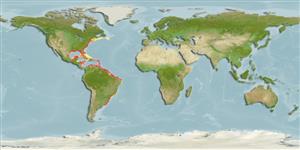Malacostraca |
Decapoda |
Portunidae
Environment: milieu / climate zone / Mức độ sâu / distribution range
Sinh thái học
Sống nổi và đáy; Nước ngọt; Thuộc về nước lợ; Mức độ sâu 0 - 90 m (Tài liệu tham khảo 109245), usually 0 - 35 m (Tài liệu tham khảo 367). Tropical; 6°C - 30°C (Tài liệu tham khảo 105839), preferred 25°C (Tài liệu tham khảo 107945); 47°N - 36°S, 125°W - 34°W
Western Atlantic: From Nova Scotia to Rio de la Plata, Argentina. Introduced in the eastern Atlantic, North Sea, Mediterranean Sea, Adriatic Sea, Black Sea and Indo-Pacific. Tropical to temperate.
Length at first maturity / Bộ gần gũi / Weight / Age
Chín muồi sinh dục: Lm 12.8, range 13 - 13 cm Max length : 22.7 cm WD con đực/không giới tính; (Tài liệu tham khảo 367); Tuổi cực đại được báo cáo: 3.00 các năm (Tài liệu tham khảo 105839)
Carapace more than twice as broad as long; 9 blunt to acuminate teeth (outer orbital tooth and strong lateral spine included) on arched anterolateral margin; front (excluding inner orbital angles) bearing 2 obtuse to acuminate, broadly triangular teeth with often sinuous inner margins longer than outer margins. Much of convex dorsal surface smooth, but scattered and transverse lines of fine granules; sculpture of regions near center varying from low and smooth to rather sharply raised relief with crowded granules; pincers strong, dissimilar, and ridged longitudinally; fifth legs flattened in form of paddles. Males with T-shaped abdomen level of thoracic sternite 4; slender first pleopods with membranous tip reaching beyond suture between thoracic sternites 4 and 5; sinuously curved overlapping proximally and armed distally with a row of large and small retrogressive spinules. Color: greyish, bluish, or brownish green. Males with propodi of chelae blue on inner and white on outer surfaces, fingers blue on inner and white on outer surfaces and tipped with red. Mature females with orange fingers on chelae tipped with purple. Underparts off-white with tints of yellow and pink. Color variations is associated with sexual dimorphism and molt cycle.
An epibenthic omnivore, that is active and abundant in shallow habitats (Ref. 087949). Longevity was estimated from a population of blue crabs in Chesapeake Bay (Ref. 105839). Benthopelagic (Ref. 97531). Hatching occurs in mouths of estuaries and shallow marine waters, development of larvae progresses in the ocean, followed by migration of megalopae and young crabs back into estuarine waters to mature into adults (Ref. 367). Found on soft bottoms (Ref. 106866). Burrows in muddy-sand bottoms (Ref. 108781). Juveniles occur on seagrasses. Highly cannibalistic; adult conspecifics are observed attacking tethered juveniles (Ref. 106866). Appears to be an opportunistic feeder (Ref. 108779).
Members of the order Decapoda are mostly gonochoric. Mating behavior: Precopulatory courtship ritual is common (through olfactory and tactile cues); usually indirect sperm transfer.
Tavares, M. 2003 True Crabs. pp. 327-352. In Carpenter, K.E. (ed.) The living marine resources of the Western Central Atlantic. Volume1: introdution, molluscs, crustaceans, hagfishes, sharks, batoid fishes, and chimaeras. FAO Species Identification Guide for Fishery Purposes and American Society of Ichthyologists and Herpetologists Special PublicationNo. 5. Rome, FAO. pp. 1-600. (Tài liệu tham khảo 367)
IUCN Red List Status
(Tài liệu tham khảo 130435: Version 2025-1)
CITES status (Tài liệu tham khảo 108899)
Not Evaluated
CMS (Tài liệu tham khảo 116361)
Not Evaluated
Threat to humans
Human uses
Các nghề cá: Tính thương mại
FAO - Nuôi trồng thủy sản: production; Các nghề cá: landings, species profile | FishSource | Biển chung quanh ta
Các công cụ
Thêm thông tin
Human RelatedStamps, coins, misc.
Các nguồn internet
Estimates based on models
Preferred temperature
(Ref.
115969): 12.3 - 28, mean 24.4 (based on 788 cells).
Thích nghi nhanh
Chiêù cao, thời gian nhân đôi của chủng quần tối thiểu là dưới 15 tháng (K=0.5-1.59; tmax=3).
Prior r = 0.89, 95% CL = 0.59 - 1.34, Based on 2 full stock assessments.
Fishing Vulnerability
Low vulnerability (16 of 100).
Climate Vulnerability
Low to moderate vulnerability (33 of 100).
Nutrients : Calcium = 109 [35, 184] mg/100g; Iron = 1.59 [1.21, 1.97] mg/100g; Protein = 20.2 [19.2, 21.3] %; Omega3 = 0.285 [0.185, 0.386] g/100g; Selenium = 48.3 [-31.7, 128.3] μg/100g; VitaminA = 0 μg/100g; Zinc = 1.79 [1.17, 2.40] mg/100g (wet weight); based on
nutrient studies.
